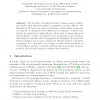Free Online Productivity Tools
i2Speak
i2Symbol
i2OCR
iTex2Img
iWeb2Print
iWeb2Shot
i2Type
iPdf2Split
iPdf2Merge
i2Bopomofo
i2Arabic
i2Style
i2Image
i2PDF
iLatex2Rtf
Sci2ools
SACRYPT
2007
Springer
2007
Springer
Collisions for 70-Step SHA-1: On the Full Cost of Collision Search
The diversity of methods for fast collision search in SHA-1 and similar hash functions makes a comparison of them difficult. The literature is at times very vague on this issue, which makes comparison even harder. In situations where differences in estimates of attack complexity of a small factor might influence short-term recommendations of standardization bodies, uncertainties and ambiguities in the literature amounting to a similar order of magnitude are unhelpful. We survey different techniques and propose a simple but effective method to facilitate comparison. In a case study, we consider a newly developed attack on 70-step SHA-1, and give complexity estimates and performance measurements of this new and improved collision search method.
| Added | 09 Jun 2010 |
| Updated | 09 Jun 2010 |
| Type | Conference |
| Year | 2007 |
| Where | SACRYPT |
| Authors | Christophe De Cannière, Florian Mendel, Christian Rechberger |
Comments (0)

